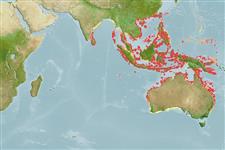| Native range | All suitable habitat | Point map | Year 2100 |

|
| This map was computer-generated and has not yet been reviewed. |
| Abudefduf bengalensis AquaMaps Data sources: GBIF OBIS |
Human uses
Pesca: scarso interesse commerciale
Phylogenetic diversity index
(Ref. 82805)
PD50 = 0.5000 many relatives (e.g. carps) 0.5 - 2.0 few relatives (e.g. lungfishes)
Trophic Level
(Ref. 69278)
3.1 ±0.46 se; Based on food items.
Resilienza
(Ref. 69278)
Medio, tempo minimo di raddoppiamento della popolazione 1.4 - 4.4 anni (Preliminary K or Fecundity.)